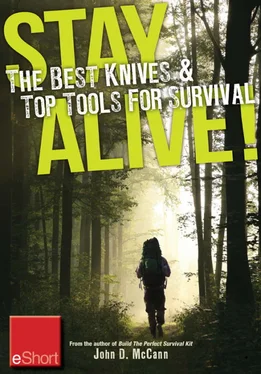Can batoning break the knife?
Is batoning good for a knife? Well that depends. The proper way to baton is to place the blade straight across the wood being batoned. This allows the force of the baton, hitting the back of the knife, to direct that force straight into the piece of wood you are trying to split. You might have to hit the front or rear of the knife blade once it is past the top portion of the wood you are splitting, and the back of the blade is no longer available to hit. But don’t start by hitting the back of the blade on the front end of the knife. This will stress the blade and it might break. It does happen and you must take this into consideration.
I have been batoning most of my adult life and after hundreds of times, I have never personally broken a knife blade. But, I am also careful. I try to get a feel for the wood, and if it feels to hard, I don’t force it, but try another piece of wood.
I have seen many videos where people prove they can break a knife while batoning, and it normally occurs when trying to baton bricks or concrete blocks. My advice is don’t baton bricks or concrete blocks. A knife is made to cut wood, so I would limit myself to those parameters. Whenever possible, I try to avoid hardwoods, unless they are of small diameter.
My recommendation is to always use a fixed blade, full tang knife for batoning. As indicated, any type of batoning can stress a knife, especially between the blade and tang, so use the strongest knife you can. I’m often asked if you can baton with a folder. I don’t recommend it, but for making kindling, if it is all you have, don’t lock the blade. Leave the handle about, what I call, half cocked. Be careful, stick with small wood, and don’t use major force with the baton.
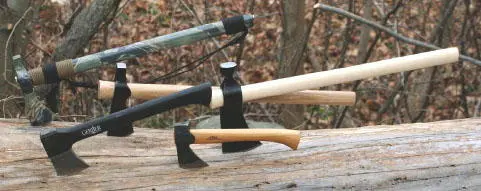
Hawks and hatchets are small enough to carry on a pack. The real small hatchet on the right of the front row is a Gransfors Bruks Mini Hatchet which is probably the lightest yet effective available. It can be carried in a medium size kit or custom carry rigs can be made.
Hatchets and hawks are another option as cutting tools and are usually small and light enough to carry in a large survival kit or pack. I’m sure you are getting tired of hearing this, but these are another tool to carry at your discretion. They can be used to chop and baton. They can also be used with the hand chocked close to the blade for some fine work as well as planing a board flat, such as for a fire board for bow and drill.
One of the advantages of a hawk is that the head can be used in the hand, without the handle. A handle can be made in the field very quickly, and a very interesting YouTube video is available from IAWoodsman on that subject, called “Cold Steel Trail Hawk.” You will be surprised at the versatility of a hawk in the field. After watching that video, you just might decide to carry only the head, and if a handle is needed, make one in the field.

The Mk-V custom hawk by Equinoxcoronado.com in a tiger stripe pattern.
If you are looking for some interesting hawks with some additional versatility, you might want to check out equinoxcoronado.com. They make the Mk-V Hawk with a custom composite handle which has a .50 caliber tube through the length of the handle. This tube has chloroprene plugs that are secured by turning stainless heads which expand the plugs to hold them in place. The tube can be used for various purposes, including as a blow gun or blow tube for fire, or to hold a survival kit. They also offer a product called the ECO-Hawk which is just a head with various blades. It can be handheld or easily attached to a stick to make a field hawk type tool.
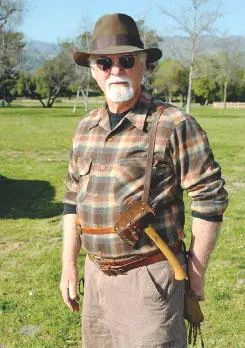
Dude McLean wears a custom shoulder rig made for a Gransfors Bruks Mini Hatchet which, like a Baldric rig, can be worn outside of a jacket for easy access. (Photo by Alan Halcon)
A very small hatchet which can be carried in almost any small pack, or attached to a belt, is the Gransfors Bruks Mini Hatchet. Although very light, it is effective at small chores and with a very sharp convex grind works well at batoning. It also has a small hammer head allowing its use to pound stakes for a tarp, or other chores.
Another nice little hatchet is made by Gerber and is called the Sport Axe. It is 13-7/8 inches long and can be carried on or in a pack. Gerber makes various other lengths, but I find the Sport a good size for the money for larger kits or packs.
There are many other manufacturers of hatchets and another good one for a larger kit is the American Snow & Neally Penobscot Bay Axe (It is called an axe but, being 17 inches long overall, it’s a hatchet in my mind). Although I have not personally used this model, a good friend of mine, Steve “Critr” Davis, the Lead Instructor for the Pathfinder School of Survival, has tested this model extensively and highly recommends it. I trust his judgment.
I have not addressed axes and do not want anyone to think they have been disregarded. They are large tools and are not normally carried with a survival kit. They are a handy item for a truck kit, if you are skilled in their use. If you want to carry one, that is your choice, but as an injury can be extremely severe, learn the proper use before planning to use one in a survival situation.
The are various type saws that can be carried in a survival kit. I have always found that their versatility makes them ideal for many survival situations. They come in many configurations and sizes, so let’s look at a few that can easily be carried in different size kits.
Wire saws
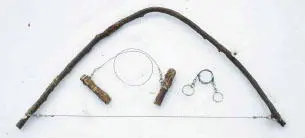
The cable saw can be used with a sapling as a bow saw or with hand holds made from branches. Rolled tightly, it can be carried in a mini or small survival kit.
A wire saw is exactly that. It is constructed of eight strands of interwoven stainless steel wire. Split ring handles swivel providing twist-free performance. It can also be used to make a bow saw and will slide over itself, for use as an emergency snare, by placing the small ring through the larger ring. This saw fits in an “Altoids” tin survival kit.
When using with the split rings on the ends, I recommend cutting two short pieces of a branch and placing them through the rings instead of trying to saw with your fingers through the split rings. This provides a more substantial hand hold. When making a bow saw, get a sturdy bendable sapling and notch each end so that the split rings stay attached to each end without sliding up.
Pocket chain saws
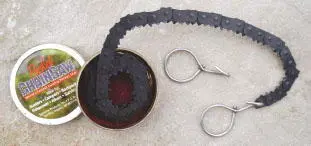
The pocket chain saw is a clever device for some serious survival cutting.
The pocket chain saw is a great addition to any survival kit. It features 124 bi-directional, heat treated steel cutting teeth that cut on both the upstroke and the down stroke. Also, since it is flexible, it wraps around the wood on three sides, increasing its efficiency. In a survival situation, this saw is safer than an axe or power chain saw since it won’t bounce off a log into a leg or foot. By attaching a cord to each end, it can cut limbs in hard-to-reach places. It stores in a small metal can about the size of a small shoeshine tin and easily fits in a shirt pocket.
Читать дальше
